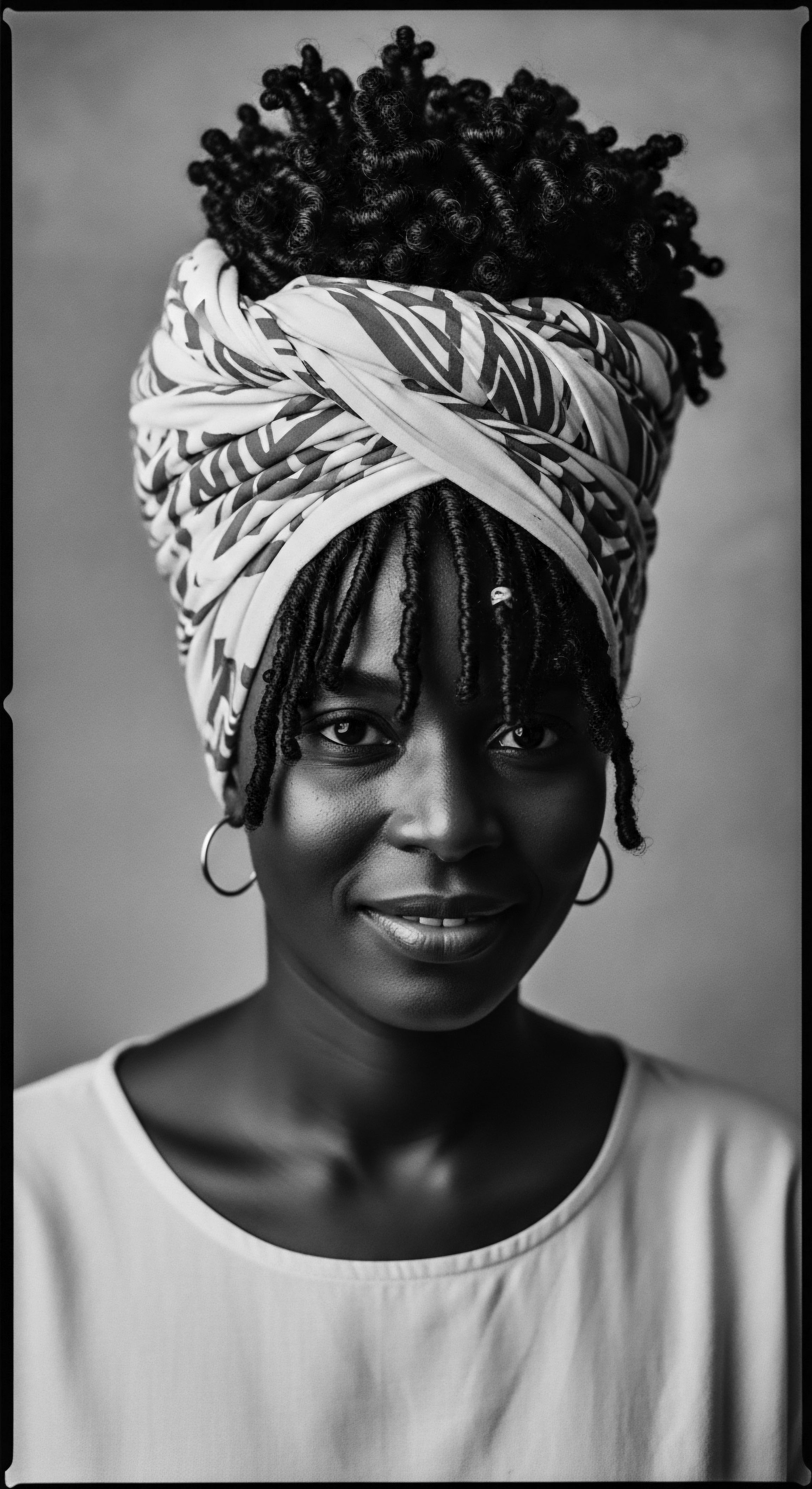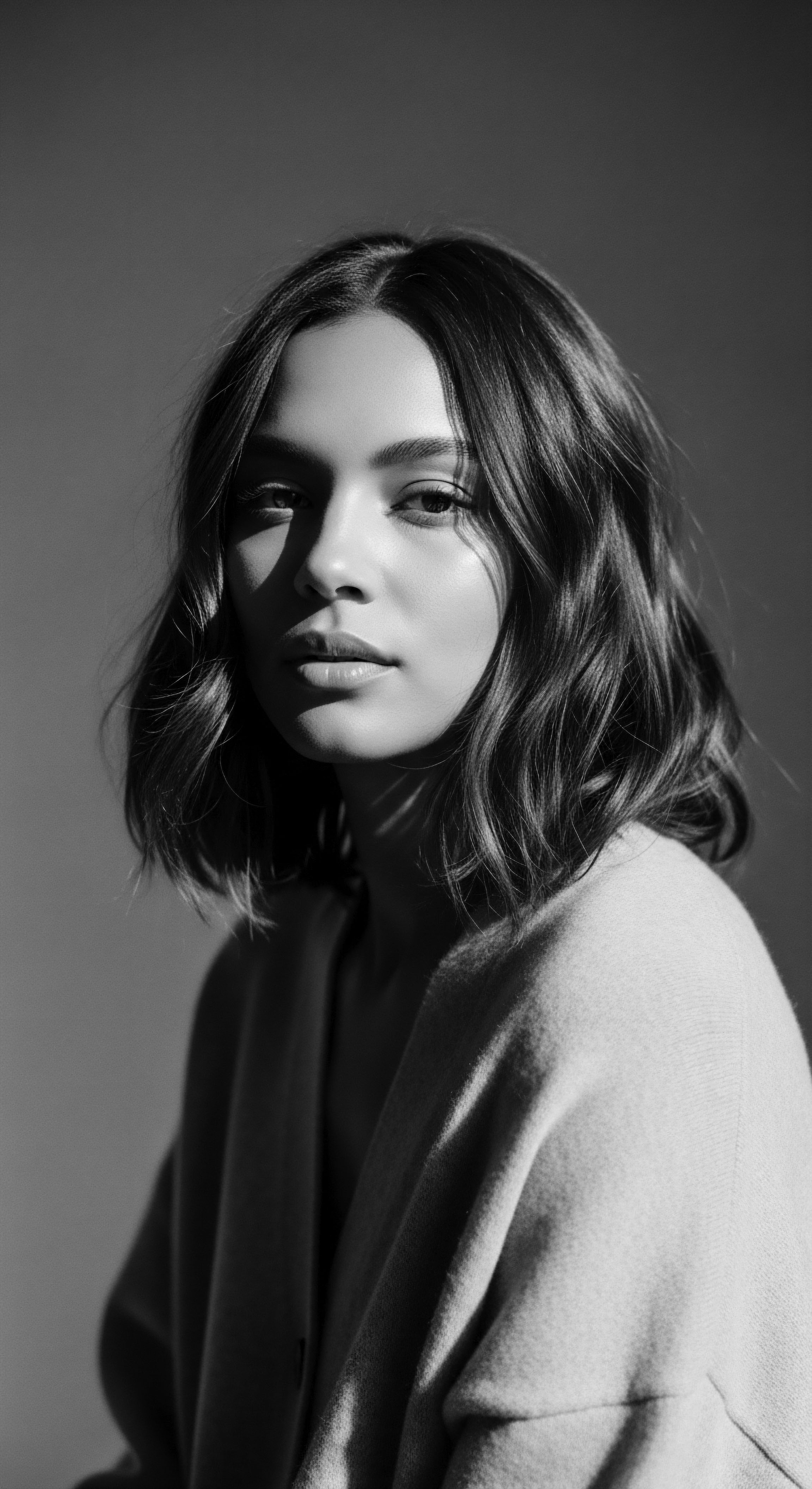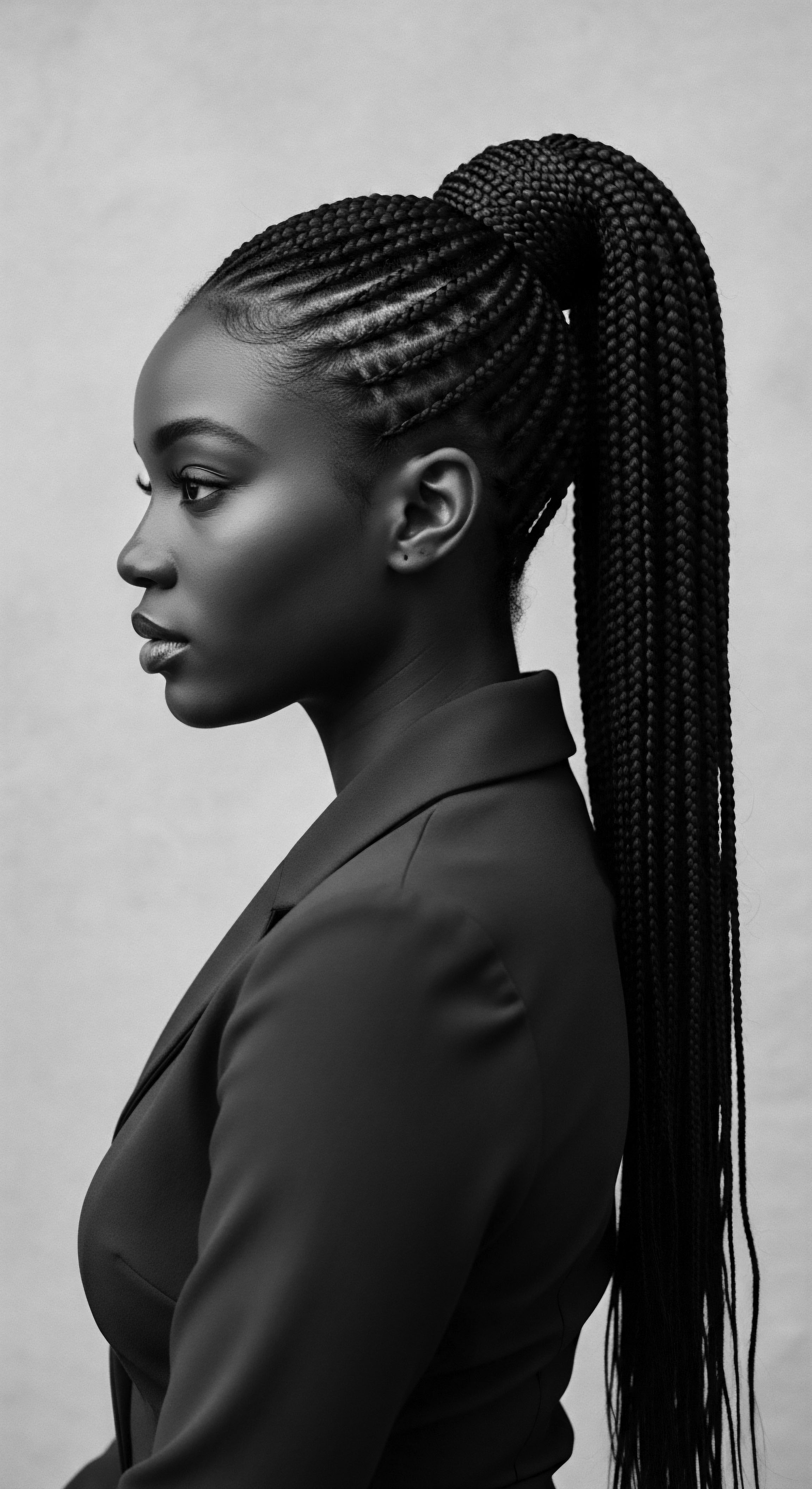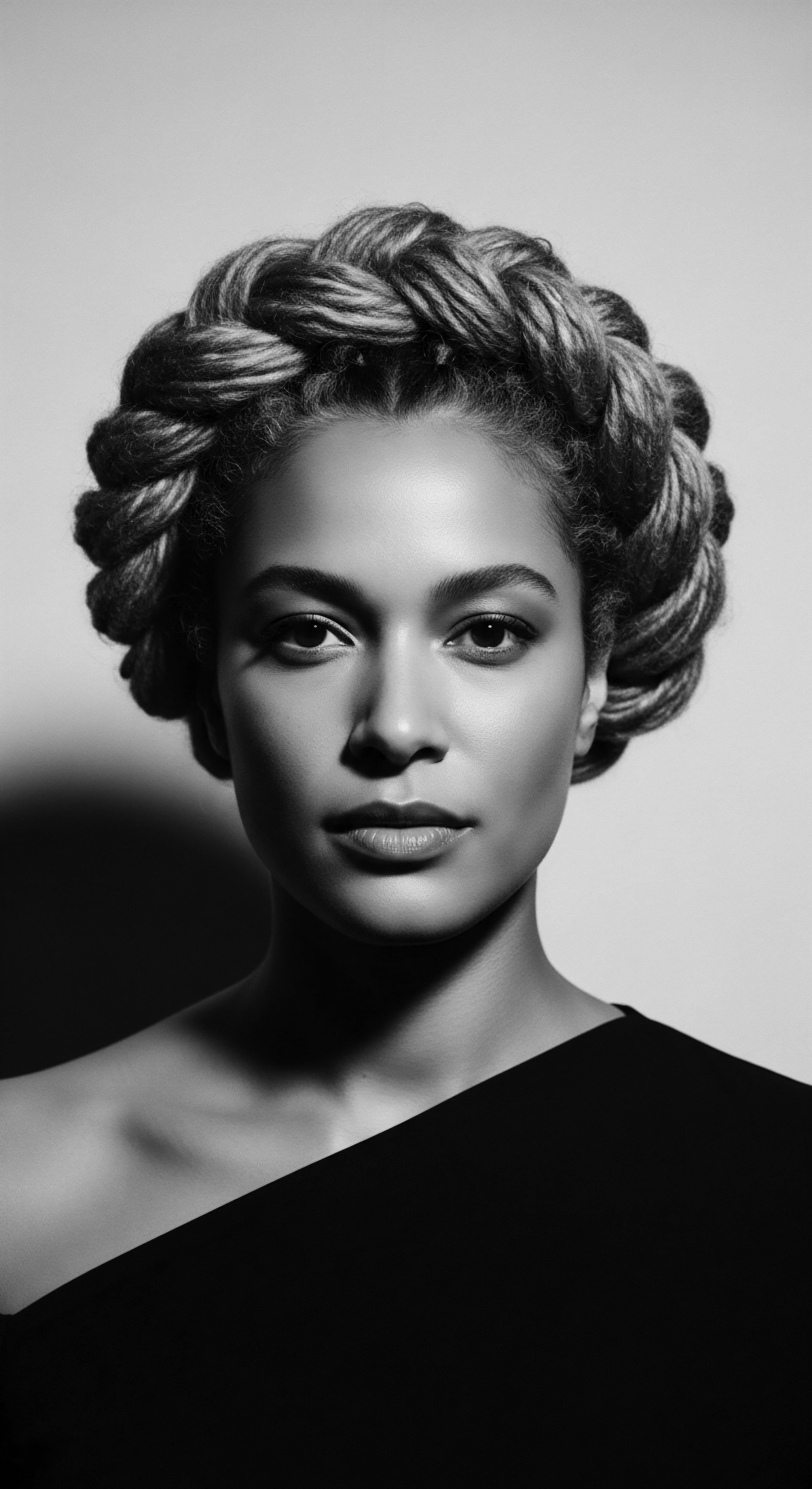
Roots
Look at the helix of your hair, trace its curve, feel its spring. Within each coil, a whisper resides, a living archive of generations, a story of survival etched not on parchment, but within the very protein bonds of your being. This journey into textured hair heritage begins not with an invention or a trend, but with the very architecture of the strand itself. It is a biological testament to resilience, an elemental biology that has faced countless historical currents, yet stands unyielding, carrying the ancestral memory of those who wore it.

The Intrinsic Strength of the Textured Hair Helix
The human hair fiber, at its core, is a remarkable structure, a keratinous protein filament. For textured hair, this filament often possesses an elliptical cross-section and a unique helical twist along its length. This very structure provides a distinctive elasticity and a natural spring, allowing the hair to coil and curve upon itself.
This inherent characteristic, often observed as coils, curls, and waves, lent itself to practical advantages in varied ancestral environments, protecting the scalp from harsh sun and insulating against temperature extremes. The natural density and collective volume of textured hair offered a shield, a biological adaptation that supported the longevity of scalp health for those living across diverse African landscapes.
Early scientific understandings, regrettably, often misinterpreted these biological distinctions, viewing them through a biased lens. But the truth of its structure speaks to an innate robustness. The varying diameters and twists along the hair shaft contribute to its strength, creating points of natural resistance. This inherent resilience, a gift of biology, formed the physical foundation upon which cultural meanings were built, a substrate for identity and resistance.

Ancestral Views and The Language of Hair
Long before modern trichology, ancient African societies possessed a nuanced understanding of hair, far beyond mere aesthetics. Hair was a powerful signifier, a visual shorthand for identity, status, and community affiliation. Hairstyles conveyed marital status, age, wealth, and even spiritual beliefs.
The art of hair styling was a communal practice, often taking hours, fostering deep bonds and transmitting ancestral knowledge from one generation to the next. This collective engagement with hair care cultivated a shared heritage, where the act of styling was a ritual of connection.
Hair, in its textured form, carried silent languages and social maps across ancient African civilizations.
The lexicon surrounding hair in these communities was rich, reflective of its social standing. Unlike later European colonial classifications which often sought to dehumanize or simplify textured hair, ancestral cultures held specific terms for different styles and their associated meanings. This was a language of reverence, a testament to the profound cultural significance of hair within daily life and ceremonial practices. The Himba people of Namibia, for example, used their hair, often coated with red ochre paste, to symbolize their connection to the earth and their ancestors, embodying a deep reverence for their lineage.
| Aspect of Hair Form and Structure |
| Ancestral Understanding A unique biological adaptation, providing natural protection and beauty. |
| Colonial Misinterpretation "Kinky," "wooly," "unmanageable," closer to animal hair than human. |
| Aspect of Hair Social Role |
| Ancestral Understanding A rich visual code signifying status, age, identity, and community bonds. |
| Colonial Misinterpretation A feature to be shorn, hidden, or "tamed" to erase identity and promote subservience. |
| Aspect of Hair Spiritual Connection |
| Ancestral Understanding A sacred antenna connecting individuals to ancestors and the divine. |
| Colonial Misinterpretation No inherent spiritual value, often dismissed as primitive or uncivilized. |
| Aspect of Hair The perception of textured hair has shifted drastically under different historical frameworks, highlighting a profound cultural clash. |

The Biological Legacy of Protection and Adaptability
The inherent qualities of textured hair, from its coil patterns to its density, played a practical role in the survival of communities across diverse climates. Its natural ability to trap moisture close to the scalp, minimizing evaporation, was particularly beneficial in arid regions. This biological endowment meant that ancient hair care practices were often centered on maintaining this moisture, using natural butters and oils sourced from the land.
Shea butter, for instance, a staple across West Africa, offered profound conditioning and protective qualities for the hair and scalp, a traditional ingredient passed down through generations. These practices were not simply about adornment; they were integral to physical well-being, an interwoven aspect of living in harmony with the environment and one’s inherited biology.

Ritual
From the foundational biology of the strand, our narrative moves to the living traditions of care and community, the sacred rituals that transformed hair into an unyielding symbol of resilience. These practices, passed down through generations, became acts of preservation in the face of immense adversity, acts of defiance against those who sought to strip away identity. The hands that braided, twisted, and adorned were not merely styling; they were inscribing heritage onto living canvas.

Styling as a Cipher and Sanctuary
When the transatlantic slave trade violently uprooted millions from their homelands, the established cultural significance of hair was systematically attacked. Enslaved Africans often had their heads shaved upon arrival, a brutal act designed to dehumanize and sever ties to their identity and heritage. Yet, even in the crucible of enslavement, the spirit of resilience manifested through hair. Traditional African braiding techniques, especially Cornrows, transformed into clandestine communication systems.
Cornrows became more than hairstyles; they were maps, messages, and reservoirs of survival during enslavement.
Enslaved people used intricate patterns in their cornrows to create maps, indicating escape routes or safe houses along the Underground Railroad. Rice and seeds were sometimes braided into the hair, providing sustenance during escape or enabling the planting of food once freedom was found. The density and texture of Afro-hair, often dismissed by oppressors, ironically aided in concealing these vital messages and items.
The hands that braided became cartographers, the scalp a living parchment of liberation. This deep history imbues cornrows with an enduring legacy of resistance and ingenuity.

The Enduring Power of Protective Styles
Protective styling, deeply rooted in ancestral practices, offered both aesthetic expression and practical benefit. These styles minimized manipulation, guarded delicate ends, and helped retain moisture, promoting hair health under harsh conditions. What began as necessity in ancestral lands became a tool for survival and cultural continuity during and after slavery.
- Braids ❉ Dating back thousands of years in Africa, braids (including box braids, Ghana braids, and microbraids) served as markers of social status, tribal affiliation, and age. Under enslavement, they continued to provide a means of keeping hair tidy and protected despite limited resources.
- Twists ❉ Similar to braids, twists (two-strand, three-strand, flat twists) offered versatility and protection. They allowed for ease of maintenance when access to elaborate tools or products was scarce.
- Locs ❉ Historically and spiritually significant in various African cultures, locs represented a connection to the divine, wisdom, and strength. Despite being demonized during colonial periods, they persist as a powerful statement of heritage and natural beauty.
- Headwraps ❉ Beyond their aesthetic appeal, headwraps provided practical protection from the sun and elements, and during enslavement, they became a means to cover hair that could not be adequately cared for. Later, they became powerful symbols of dignity and cultural pride, a vibrant display of heritage even when overt hairstyles were suppressed (as seen with the Tignon Laws in 18th-century Louisiana).

Challenges to Expression and Acts of Defiance
The history of textured hair is also marked by attempts to suppress its natural form and cultural expression. The Tignon Laws, enacted in Louisiana in 1786, mandated that women of African descent, free or enslaved, cover their hair with a knotted headdress or “tignon” when in public. This law aimed to diminish their perceived social status and curb their attractiveness to white men, asserting a visual hierarchy.
However, these women, with remarkable defiance, transformed the tignon itself into a statement of artistry, using luxurious fabrics and elaborate wrapping techniques, thereby subverting the law’s original intent. This act embodies resilience; an oppressive measure became a canvas for continued self-expression and cultural pride.
The widespread pressure to conform to Eurocentric beauty standards led many Black individuals to straighten their hair using harsh chemicals or hot combs, methods that often caused significant damage to the hair and scalp. This practice, while stemming from societal pressures to assimilate for social and economic survival, did not erase the desire to maintain ancestral hair traditions. Even amidst these challenges, the communal aspects of hair care persisted, often behind closed doors, preserving a continuity of knowledge and shared experience that fortified the spirit.
| Historical Period Ancient Africa (3500 BCE onwards) |
| Cultural Significance/Function Signified tribal identity, social status, age, wealth, religion, and even marital status; communal bonding ritual. |
| Historical Period Transatlantic Slave Trade Era (1500s-1800s) |
| Cultural Significance/Function Used as coded maps for escape routes, hiding places for seeds/gold, and a discreet communication medium among enslaved people. A tool for survival and rebellion. |
| Historical Period Post-Slavery Era to Early 20th Century |
| Cultural Significance/Function Continued as a practical style, often hidden under headwraps due to societal pressure to conform to Eurocentric aesthetics. |
| Historical Period Civil Rights/Black Power Movements (1960s-1970s) |
| Cultural Significance/Function Reclaimed as a symbol of Black pride, resistance, and connection to African heritage, challenging dominant beauty standards. |
| Historical Period Contemporary Era |
| Cultural Significance/Function A versatile, protective style celebrated for its artistry and cultural heritage, though still facing discrimination in some formal settings. |
| Historical Period Cornrows stand as a powerful testament to the enduring adaptability and messaging capabilities of textured hair throughout history. |

Relay
The journey of textured hair, having navigated the elemental truths of its biology and the sacred rituals of its care, now moves into the expansive realm of collective identity and future shaping. This is where the wisdom of the past becomes the fuel for present advocacy, where strands collectively voice defiance and demand recognition, proving that resilience is not merely survival, but a conscious choice to thrive and define one’s own beauty.

From Assimilation Pressure to Assertive Identity
For centuries, the dominant societal gaze in Western cultures often viewed natural textured hair with disdain, labeling it as “unprofessional” or “unkempt”. This perception, deeply rooted in the ideologies of slavery and colonialism, pushed many Black individuals towards chemical straightening and other methods to conform to Eurocentric beauty standards. The pressure was immense, often impacting employment opportunities and social acceptance. Yet, within this landscape of external pressure, a profound internal resilience simmered, awaiting its moment to surface.
The mid-20th century marked a turning point. As the Civil Rights Movement gained momentum, a parallel awakening occurred within the Black community concerning identity and self-acceptance. The Afro, a voluminous natural hairstyle, emerged as a potent symbol of Black pride and resistance during the 1960s and 1970s. Figures like Angela Davis and members of the Black Panther Party wore their Afros as a political statement, challenging societal norms and embracing their African heritage unapologetically.
This was a powerful rejection of the notion that Black hair needed to be “tamed” or altered to be deemed acceptable. It declared that “Black is Beautiful,” a movement that transcended mere aesthetics to encompass a holistic affirmation of Blackness.

The Modern Quest for Legal Recognition
Despite the powerful cultural shifts of the 20th century, discriminatory practices against textured hair persisted in schools and workplaces. Individuals with braids, locs, twists, or natural Afros continued to face bias, ranging from being sent home from school to being denied employment or promotion. This reality underscored the ongoing struggle for true hair liberation, demonstrating that cultural acceptance alone was not enough; legal protection was essential.
In response to this systemic bias, the CROWN Act (Creating a Respectful and Open World for Natural Hair) emerged as a crucial legislative effort. California was the first state to pass the CROWN Act in 2019, prohibiting discrimination based on hair texture and protective hairstyles associated with race. As of June 2023, twenty-three states in the U.S. have passed similar legislation.
This legislative movement recognizes that hair discrimination is a form of racial discrimination, directly linking hair to racial identity, and aims to safeguard the right of individuals to wear their natural hair without fear of penalty. The existence and passage of the CROWN Act symbolizes a continued, organized assertion of resilience, translating cultural pride into legal precedent.
A 2017 study found that Black women feel more anxiety about their hair and are twice as likely as white women to feel pressure to straighten their hair in the workplace (Martin, 2017). This statistic powerfully illustrates the pervasive nature of hair discrimination and the systemic pressure faced by individuals with textured hair, even in modern times. The CROWN Act directly addresses this lived experience, aiming to dismantle policies rooted in white standards of appearance that perpetuate racist stereotypes.

Holistic Wellness and Ancestral Echoes
The contemporary natural hair movement reflects a deeper return to holistic wellness and ancestral wisdom. It prioritizes the health of the scalp and strands, drawing inspiration from ancient practices and ingredients. Many now seek formulations that align with the specific needs of textured hair, often incorporating traditional components known for their nourishing properties.
- Shea Butter ❉ A historical cornerstone of African hair care, cherished for its moisturizing and healing properties, rich in vitamins and fatty acids.
- African Black Soap ❉ Traditionally used as a cleanser, made from plantain skins, cocoa pods, and palm oil, known for purifying without stripping natural oils.
- Chebe Powder ❉ Originating from the Basara Arab women of Chad, this powder is applied to hair to reduce breakage and promote length retention, a secret passed down through generations.
The resurgence of these traditional ingredients and methods signals a desire for hair care that is not only effective but also culturally resonant. It represents a conscious choice to honor heritage in daily rituals, connecting modern care practices to the enduring legacy of those who preserved this knowledge against all odds. This deeper engagement with heritage, science, and personal well-being affirms textured hair as a continuous source of strength and self-definition.

Reflection
The story of textured hair is an unwavering testament to the enduring power of the human spirit. Each coil and curl, each braid and twist, carries the echoes of countless generations who faced immense pressures, yet refused to yield their authentic selves. It is a chronicle written on the very head, a living library of survival, ingenuity, and profound beauty. From ancient markings of identity to clandestine maps of freedom, and now to a vibrant, global reclamation of self, textured hair has consistently served as an undeniable declaration.
It reminds us that resilience is not merely about enduring hardship, but about transforming adversity into a vibrant, undeniable expression of one’s inherent worth and a sacred connection to all that came before. In this ongoing journey, the soul of a strand continues to teach us the boundless strength found in embracing our truest heritage.

References
- Byrd, Ayana, and Lori L. Tharps. Hair Story ❉ Untangling the Roots of Black Hair in America. St. Martin’s Publishing, 2021.
- Caldwell, Paulette. “A Hair Piece ❉ Perspectives on the Intersection of Race and Gender.” Duke Law Journal, vol. 1991, no. 2, 1991, pp. 365–396.
- Dabiri, Emma. Don’t Touch My Hair. Penguin Books, 2019.
- Hooks, Bell. Black Looks ❉ Race and Representation. South End Press, 1992.
- Martin, Areva. “The Hatred of Black Hair Goes Beyond Ignorance.” Time, 23 Aug. 2017.
- Murrow, Willie L. 400 Years without A Comb. 1974.
- Rooks, Noliwe M. Hair Raising ❉ Beauty, Culture, and African American Women. Rutgers University Press, 1996.
- White, Verona. “Celebrating the history and beauty of afro-textured hair.” Issuu, 2023.
